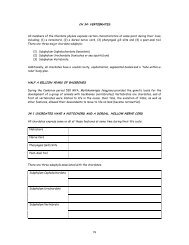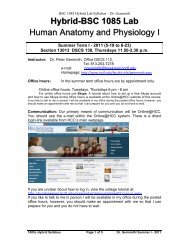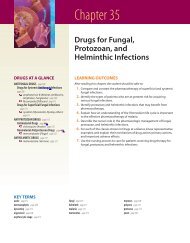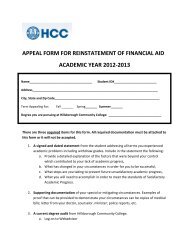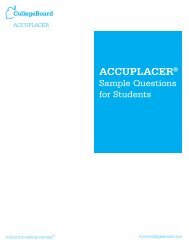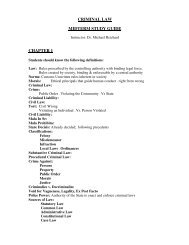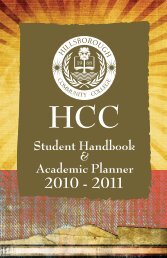Antimicrobial Drugs
Antimicrobial Drugs
Antimicrobial Drugs
You also want an ePaper? Increase the reach of your titles
YUMPU automatically turns print PDFs into web optimized ePapers that Google loves.
M34_ADAM9811_03_SE_CH34.QXD 12/30/09 1:16 PM Page 490<br />
490 Unit 5 The Immune System<br />
Prototype Drug<br />
Therapeutic Class: Antibacterial<br />
❘ Erythromycin (E-Mycin, Erythrocin)<br />
Pharmacologic Class: Macrolide; protein synthesis inhibitor<br />
ACTIONS AND USES<br />
ADVERSE EFFECTS<br />
Erythromycin is inactivated by stomach acid and is thus formulated as coated,<br />
acid-resistant tablets or capsules that dissolve in the small intestine.Its main application<br />
is for patients who are unable to tolerate penicillins or who may have<br />
a penicillin-resistant infection.It has a spectrum similar to that of the penicillins<br />
and is effective against most gram-positive bacteria. It is often a preferred drug<br />
for infections by Bordetella pertussis (whooping cough) and Corynebacterium<br />
diphtheriae.<br />
ADMINISTRATION ALERTS<br />
■ Administer oral drug on an empty stomach with a full glass of water.<br />
■ For suspensions,shake the bottle thoroughly to ensure the drug is well mixed.<br />
■ Do not give with or immediately before or after fruit juices.<br />
■ Pregnancy category B<br />
PHARMACOKINETICS<br />
Onset: 1 h<br />
Peak: 1–4 h<br />
Half-life: 1.5–2 h<br />
Duration: Unknown<br />
The most frequent adverse effects from erythromycin are nausea, abdominal<br />
cramping, and vomiting, although these are rarely serious enough to cause discontinuation<br />
of therapy. Concurrent administration with food reduces these<br />
symptoms.The most severe adverse effect is hepatotoxicity caused by the estolate<br />
salt (Ilosone) of the drug. Hearing loss, vertigo, and dizziness may be experienced<br />
when using high doses, particularly in older adults and in those with<br />
impaired hepatic or renal excretion.<br />
Contraindications: Erythromycin is contraindicated in patients with hypersensitivity<br />
to drugs in the macrolide class, and for those taking terfenadine, astemizole,<br />
or cisapride.<br />
INTERACTIONS<br />
Drug–Drug: Anesthetics, azole antifungals and anticonvulsants may interact to cause<br />
serum drug levels of erythromycin to rise and result in toxicity.This drug interacts<br />
with cyclosporine, increasing the risk for nephrotoxicity. It may increase the effects of<br />
warfarin.The concurrent use of erythromycin with lovastatin or simvastatin is not<br />
recommended because it may increase the risk of muscle toxicity. Ethanol use may<br />
decrease the absorption of erythromycin.<br />
Lab Tests: Erythromycin may interfere with AST and give false urinary catecholamine<br />
values.<br />
Herbal/Food: St. John’s wort may decrease the effectiveness of erythromycin.<br />
Treatment of Overdose: There is no specific treatment for overdose.<br />
Refer to MyNursingKit for a Nursing Process Focus specific to this drug.<br />
TABLE 34. 6<br />
Aminoglycosides<br />
Drug Route and Adult Dose (max dose where indicated) Adverse Effects<br />
amikacin (Amikin) IM; 5.0–7.5 mg/kg as a loading dose, then 7.5 mg/kg bid Pain or inflammation at injection site, rash, fever, nausea,<br />
gentamicin (Garamycin, others) IM; 1.5–2.0 mg/kg as a loading dose, then 1–2 mg/kg bid–tid<br />
diarrhea, dizziness, tinnitus<br />
kanamycin (Kantrex)<br />
IM; 5.0–7.5 mg/kg bid–tid<br />
Anaphylaxis, nephrotoxicity, irreversible ototoxicity,<br />
superinfections<br />
neomycin<br />
PO; 4–12 g/day in divided doses<br />
paromomycin (Humatin)<br />
PO; 7.5–12.5 mg/kg in three doses<br />
streptomycin<br />
IM; 15 mg/kg up to 1 g as a single dose<br />
tobramycin (Nebcin)<br />
IM/IM; 1 mg/kg tid (max: 5 mg/kg/day)<br />
Italics indicate common adverse effects; underlining indicates serious adverse effects.<br />
34.12 Pharmacotherapy<br />
with Aminoglycosides<br />
Aminoglycosides are bacteriocidal and act by inhibiting<br />
bacterial protein synthesis. They are normally reserved for<br />
serious systemic infections caused by aerobic gram-negative<br />
organisms, including those caused by E. coli, Serratia, Proteus,<br />
Klebsiella, and Pseudomonas. They are sometimes administered<br />
concurrently with a penicillin, cephalosporin, or<br />
vancomycin for treatment of enterococcal infections. When<br />
used for systemic bacterial infections, aminoglycosides are<br />
given parenterally because they are poorly absorbed from<br />
the GI tract. They are occasionally given orally for their local<br />
effect on the GI tract to sterilize the bowel prior to intestinal<br />
surgery. Neomycin is available for topical infections<br />
of the skin, eyes, and ears. Paromomycin (Humatin) is<br />
given orally for the treatment of parasitic infections. Once<br />
widely used, streptomycin is now usually restricted to the<br />
treatment of tuberculosis because of the emergence of a<br />
large number of strains resistant to the antibiotic. The<br />
nurse should note the differences in spelling of some<br />
drugs—such as -mycin versus -micin—which reflect the<br />
different organisms from which the drugs were originally<br />
isolated.<br />
# 102887 Cust: PE/NJ/CHET Au: ADAMS Pg. No. 490<br />
Title: Pharmacology for Nurses Server: Jobs2<br />
C/M/Y/K<br />
Short / Normal<br />
DESIGN SERVICES OF<br />
S4CARLISLE<br />
Publishing Services



